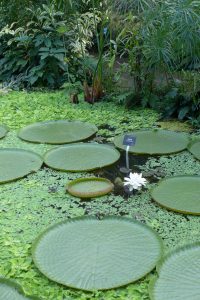Giant Water Lily
Victoria amazonica
Family: Nymphaeaceae
Description: The upper surface has a rather quilted appearance. The purplish-red under surface has a network of ribs, clad in abundant sharp spines, possibly a defence against herbivorous fishes and manatees. Air trapped in the spaces between the ribs enables the leaves to float. The flowers are white and open at night, and once pollinated by a beetle they turn pink the second night.
Place of origin: The Victoria amazonica is native to tropical South America; it was first discovered in Bolivia in 1801, and named the Eurgale amazoinica. It was subsequently moved to a new genus named in honor of Queen Victoria (originally as Victoria regia). In South America it grows in the back waters of rivers in the Amazon basin, the Guiana’s and the Pantanal.
Did you know?
The Victoria amazonica is so buoyant that they could easily support a small child if their weight was distributed evenly over the leaf, but this is not recommended! It is said that the seeds of this species can be roasted and eaten.

